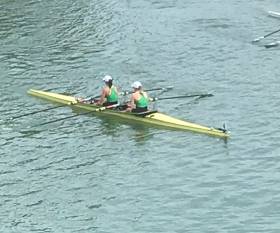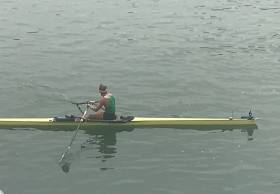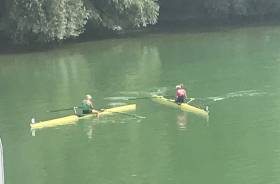Displaying items by tag: World Rowing Championships
Olympic Place Evades Ireland Women's Four at World Championships
#Rowing: Ireland's ambitions of booking a slot for a fifth boat at Tokyo 2020 came up short. The Ireland four of Tara Hanlon, Eimear Lambe, Aifric Keogh and Emily Hegarty had the difficult task of taking a top-two place in their B Final. They found their pace coming up to the line, but Britain, in lane five, and Canada in lane six took the crucial spots, with Ireland finishing fourth behind third-placed China.
The crosswind was a problem during the race and immediately afterwards the authorities redrew the lanes to acknowledge that lanes five and six were favoured.
World Rowing Championshiops, Linz-Ottensheim, Day Seven (Irish interest)
Women
Four - B Final (First Two book Olympic places for boat): 1 Britain 6:55.08, 2 Canada 6:56.99; 3 China 7:02.28, 4 Ireland Ireland (T Hanlon, E Lambe, A Keogh, E Hegarty) 7:02.71.
Pair - B Final (First Five book Olympic places for boat): 1 Romania 7:18.88, 2 Ireland (A Crowley, M Dukarska) 7:20.68.
Lightweight Double Sculls - C Final (Places 13 to 18) 1 China 7:00.82; 5 Ireland (A Casey, D Walsh) 7:10.52.
Fast Finish But Walsh and Casey Finish Fifth in C Final
#Rowing: Ireland's lightweight double of Aoife Casey and Denise Walsh took fifth in their C Final, 17th overall at the World Rowing Championships in Linz-Ottensheim this morning. China were strong winners. Ireland came from sixth to fifth in the second half of the race. They had the fastest final 500 metres but were held out of fourth by Germany - by .68 of a second.
World Rowing Championshiops, Linz-Ottensheim, Day Seven (Irish interest)
Women
Lightweight Double Sculls - C Final (Places 13 to 18) 1 China 7:00.82; 5 Ireland (A Casey, D Walsh) 7:10.52.
#Rowing: Ireland qualified a second boat for the Olympic Games today. The Ireland double of Philip Doyle and Ronan Byrne controlled their semi-final to win from Romania and Britain, who also qualified for the A Final.
The middle stages were superb. Ireland moved away from early leaders New Zealand and led Britain coming through the 1500 metres. From there came the charges of the other boats, but Doyle and Byrne repelled them all.
World Rowing Championships, Linz-Ottensheim, Day Six (Irish interest)
Men
Lightweight Quadruple - B Final: 1 United States 6:03.94, 2 Ireland (H Sutton, M Taylor, R Ballantine, J McCarthy) 6:06.62.
Double - A/B Semi-Final Two: 1 Ireland (P Doyle, R Byrne) 6:13.88, 2 Romania 6:14.86, 3 Britain 6:15.84.
Lightweight Single - B Final (places 7 to 12): 1 Austria (R Kepplinger) 7:00.16; 4 Ireland (G O'Donovan) 7:02.18.
Women
Lightweight Single - B Final (places 7 to 12): 1 Australia (Alice Arch) 7:52.59; 5 Ireland (L Heaphy) 7:55.40.
Gary O'Donovan Tenth Overall at World Rowing Championships
#Rowing: Ireland's Gary O'Donovan took fourth in his B Final of the lightweight single sculls at the World Rowing Championships in Linz-Ottensheim.
Rainer Kepplinger of Austria won, with O'Donovan part of group close behind. The finish puts O'Donovan 10th overall here.
Alice Arch of Australia won the women's lightweight single, with Ireland's Lydia Heaphy fifth. Heaphy had led through the first quarter.
The Ireland lightweight quadruple took second to the United States in their B Final.
World Rowing Championships, Linz-Ottensheim, Day Six (Irish interest)
Men
Lightweight Quadruple - B Final: 1 United States 6:03.94, 2 Ireland (H Sutton, M Taylor, R Ballantine, J McCarthy) 6:06.62.
Lightweight Single - B Final (places 7 to 12): 1 Austria (R Kepplinger) 7:00.16; 4
Ireland (G O'Donovan) 7:02.18.
Women
Lightweight Single - B Final (places 7 to 12): 1 Australia (Alice Arch) 7:52.59; 5 Ireland (L Heaphy) 7:55.40.
#Rowing: Aoife Casey and Denise Walsh finished third in their C/D Semi-Final at the World Championships and qualified for the C Final. China, Germany and Ireland held that order through the great bulk of the race, but Ireland closed hard on Germany coming to the line, missing out on catching them by just .18 of a second.
World Rowing Championships, Linz-Ottensheim, Austria - Day Five (Irish interest)
Men
Lightweight Double Sculls - A/B Semi-Final Two (First Three to A Final; rest to B Final): 1 Ireland (F McCarthy, P O'Donovan) 6:13.46, 2 Germany 6:13.59, 3 Norway 6:14.15.
Lightweight Single Sculls A/B Semi-Final One (First Three to A Final; rest to B Final): 6 Ireland (G O'Donovan) 7:34.01.
Women
Four A/B Semi-Final Two (First Three to A Final; rest to B Final): 1 Australia 6:25.34, 2 Denmark 6:28.58, 3 Romania 6:30.96; 4 Ireland (T Hanlon, E Lambe, A Keogh, E Hegarty) 6:32.37.
Pair - A/B Semi-Final One (First Three to A Final; rest to B Final): 1 New Zealand 6:57.92, 2 United States 7:01.78, 3 Italy 7:01.80; 4 Ireland (A Crowley, M Dukarska) 7:03.05.
Lightweight Double Sculls - C/D Semi-Final One (First Three to C Final; rest to D Final): 3 Ireland (A Casey, D Walsh) 7:01.68.
Lightweight Single Sculls A/B Semi-Final One (First Three to A Final; rest to B Final): 6 Ireland (L Heaphy) 7:42.23.
Ireland Four Must Qualify for Olympics From B Final
#Rowing: The Ireland women's four finished fourth in their A/B Semi-Final at the World Championships in Linz-Ottensheim, missing out by one place on an A Final. The must now compete in a B Final, where a top-two placing would lift their boat into an Olympic place.
The first 700 metres were discouraging, but from there the crew of Tara Hanlon, Eimear Lambe, Aifric Keogh and Emily Hegarty made real progress. They moved from sixth into fifth and were in fourth coming into the final 500 metres, overlapping the Romanian crew in third. Ireland kept the pressure on, but Romania held out for third. Australia and Denmark led home.
Gary O'Donovan will also compete in a B Final. He finished a distant sixth in his semi-final of the lightweight single sculls, slowing up and paddling home in the final quarter.
Lydia Heaphy took sixth in her semi of the lightweight single. She was very much in contention for a top-three spot through the middle stages of the race, but it got away from her by the end.
World Rowing Championships, Linz-Ottensheim, Austria - Day Five (Irish interest)
Men
Lightweight Double Sculls - A/B Semi-Final Two (First Three to A Final; rest to B Final): 1 Ireland (F McCarthy, P O'Donovan) 6:13.46, 2 Germany 6:13.59, 3 Norway 6:14.15.
Lightweight Single Sculls A/B Semi-Final One (First Three to A Final; rest to B Final): 6 Ireland (G O'Donovan) 7:34.01.
Women
Four - A/B Semi-Final Two (First Three to A Final; rest to B Final): 1 Australia 6:25.34, 2 Denmark 6:28.58, 3 Romania 6:30.96; 4 Ireland (T Hanlon, E Lambe, A Keogh, E Hegarty) 6:32.37.
Pair - A/B Semi-Final One (First Three to A Final; rest to B Final): 1 New Zealand 6:57.92, 2 United States 7:01.78, 3 Italy 7:01.80; 4 Ireland (A Crowley, M Dukarska) 7:03.05.
Lightweight Single Sculls A/B Semi-Final One (First Three to A Final; rest to B Final): 6 Ireland (L Heaphy) 7:42.23.
Gary O'Donovan Sprints into World Championships Semi-Final
#Rowing: Gary O'Donovan came from fifth in his quarter-final with 500 metres to go to take third and a place in the World Championships semi-finals. The good finishing speed served the Skibbereen lightweight sculler well in Linz-Ottensheim. As four boats charged, Aaron Lattimer of Canada did best and won, while Sean Murphy of Australia held on to take second. O'Donovan took out Milos Stanojevic of Serbia, who had held second going into the final quarter.
World Rowing Championships, Linz-Ottensheim, Austria, Day Four (Irish interest)
Men
Double Sculls - Quarter-Final One - (First Three to A/B Semi-Finals; rest to C/D Semi-Finals): 1 Poland 6:15.06, 2 Ireland (P Doyle, R Byrne) 6:17.78, 3 Germany 6:21.04.
Lightweight Double Sculls - Quarter-Final Three - (First Three to A/B Semi-Finals; rest to C/D Semi-Finals): 1 Ireland (F McCarthy, P O'Donovan) 6:20.84, 2 Spain 6:22.84, 3 Poland 6:23.72.
Lightweight Single Sculls - Quarter Final Three - (First Three to A/B Semi-Finals; rest to C/D Semi-Finals): 1 Canada (A Lattimer) 6:56.90, 2 2 Australia (S Murphy) 6:57.85, 3 Ireland (G O'Donovan) 6:59.57.
Women
Pair - Quarter-Final Two (First Three to A/B Semi-Finals; rest to C/D Semi-Finals): 1 Australia 7:08.74, 2 Ireland (A Crowley, M Dukarska) 7:12.51, 3 Italy 7:13.11.
Lightweight Double Sculls - Quarter-Final Three - (First Three to A/B Semi-Finals; rest to C/D Semi-Finals): 4 Ireland (A Casey, D Walsh) 7:07.17.
Single Sculls - Quarter-Final Four - (First Three to A/B Semi-Finals; rest to C/D Semi-Finals): 1 Ireland (S Puspure) 7:21.03, 2 Czech Republic (M Topinkova Knapkova) 7:36.19, 3 Ukraine (D Dymchenko) 7:41.48.
Pararowing: Women's PR Two Single Sculls, Preliminary Race: 1 Australia (K Ross) 9:24.99; 3 Ireland (K O'Brien) 9:52.13.
Puspure Has Huge Margin as She Wins World Championship Quarter-Final
#Rowing: Sanita Puspure won the fastest quarter-final of the women's single sculls at the World Championships yesterday - with by far the biggest margin of victory. She had more than 15 seconds to spare over the 2012 Olympic champion Mirka Topinkova Knapkova of the Czech Republic.
Puspure became the third Ireland crew to go through to semi-finals in Olympic events in this Olympic qualification regatta.
World Rowing Championships, Linz-Ottensheim, Austria, Day Four (Irish interest)
Men
Double Sculls - Quarter-Final One - (First Three to A/B Semi-Finals; rest to C/D Semi-Finals): 1 Poland 6:15.06, 2 Ireland (P Doyle, R Byrne) 6:17.78, 3 Germany 6:21.04.
Lightweight Double Sculls - Quarter-Final Three - (First Three to A/B Semi-Finals; rest to C/D Semi-Finals): 1 Ireland (F McCarthy, P O'Donovan) 6:20.84, 2 Spain 6:22.84, 3 Poland 6:23.72.
Women
Pair - Quarter-Final Two (First Three to A/B Semi-Finals; rest to C/D Semi-Finals): 1 Australia 7:08.74, 2 Ireland (A Crowley, M Dukarska) 7:12.51, 3 Italy 7:13.11.
Lightweight Double Sculls - Quarter-Final Three - (First Three to A/B Semi-Finals; rest to C/D Semi-Finals): 4 Ireland (A Casey, D Walsh) 7:07.17.
Single Sculls - Quarter-Final Four - (First Three to A/B Semi-Finals; rest to C/D Semi-Finals): 1 Ireland (S Puspure) 7:21.03, 2 Czech Republic (M Topinkova Knapkova) 7:36.19, 3 Ukraine (D Dymchenko) 7:41.48.
Pararowing: Women's PR Two Single Sculls, Preliminary Race: 1 Australia (K Ross) 9:24.99; 3 Ireland (K O'Brien) 9:52.13.
Doyle and Byrne Safely into Semi-Finals in Linz
#Rowing: Ireland qualified another boat for the semi-finals at the World Championships today as Philip Doyle and Ronan Byrne took second in their quarter-final of the double sculls. A top-three place was the aim: Germany, Poland and Ireland held these by the closing stages. Poland moved clear and Ireland left Germany behind them. Coming to the line, Ireland closed a little on Poland, but the winners held on and had 2.72 seconds to spare at the end.
World Rowing Championships, Linz-Ottensheim, Austria, Day Four (Irish interest)
Men
Double Sculls - Quarter-Final One - (First Three to A/B Semi-Finals; rest to C/D Semi-Finals): 1 Poland 6:15.06, 2 Ireland (P Doyle, R Byrne) 6:17.78, 3 Germany 6:21.04.
Lightweight Double Sculls - Quarter-Final Three - (First Three to A/B Semi-Finals; rest to C/D Semi-Finals): 1 Ireland (F McCarthy, P O'Donovan) 6:20.84, 2 Spain 6:22.84, 3 Poland 6:23.72.
Women
Pair - Quarter-Final Two (First Three to A/B Semi-Finals; rest to C/D Semi-Finals): 1 Australia 7:08.74, 2 Ireland (A Crowley, M Dukarska) 7:12.51, 3 Italy 7:13.11.
Lightweight Double Sculls - Quarter-Final Three - (First Three to A/B Semi-Finals; rest to C/D Semi-Finals): 4 Ireland (A Casey, D Walsh) 7:07.17.
Pararowing: Women's PR Two Single Sculls, Preliminary Race: 1 Australia (K Ross) 9:24.99; 3 Ireland (K O'Brien) 9:52.13.
O'Donovan and McCarthy Win Way to World Semi-Finals
#Rowing: It was tight at the finish, but Paul O'Donovan and Fintan McCarthy qualified for the semi-finals of the lightweight double sculls at the World Championships with a win here in Linz-Ottensheim. Spain held the lead through much of this quarter-final, but Ireland were poised to take them and did in the final quarter. Poland took third.
The women's lightweight double dropped out of the running for a top-three place early on, but kept fighting to the line. They beat Poland in a battle for fourth. They will compete in the C/D Semi-Finals.
World Rowing Championships, Linz-Ottensheim, Austria, Day Four (Irish interest)
Men
Lightweight Double Sculls - Quarter-Final Three - (First Three to A/B Semi-Finals; rest to C/D Semi-Finals): 1 Ireland (F McCarthy, P O'Donovan) 6:20.84, 2 Spain 6:22.84, 3 Poland 6:23.72.
Women
Pair - Quarter-Final Two (First Three to A/B Semi-Finals; rest to C/D Semi-Finals): 1 Australia 7:08.74, 2 Ireland (A Crowley, M Dukarska) 7:12.51, 3 Italy 7:13.11.
Lightweight Double Sculls - Quarter-Final Three - (First Three to A/B Semi-Finals; rest to C/D Semi-Finals): 4 Ireland (A Casey, D Walsh) 7:07.17.
Pararowing: Women's PR Two Single Sculls, Preliminary Race: 1 Australia (K Ross) 9:24.99; 3 Ireland (K O'Brien) 9:52.13.































































